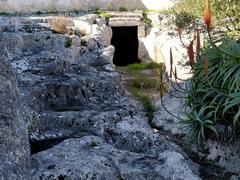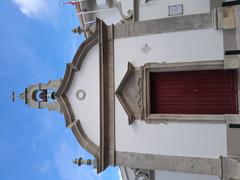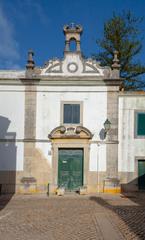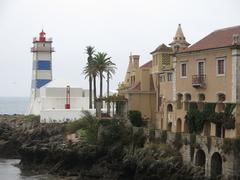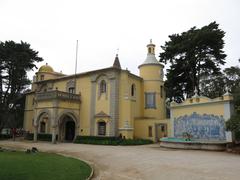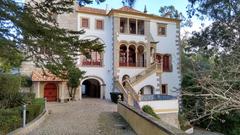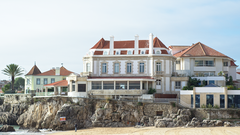Vigia do Facho: Visiting Hours, Tickets, and Complete Guide to Estoril & Cascais Historical Sites
Date: 04/07/2025
Introduction: The Legacy of Vigia do Facho
Perched along the dramatic Atlantic shoreline between Estoril and Cascais, Vigia do Facho is a symbol of Portugal’s enduring maritime heritage and coastal defense. With origins tracing back to prehistoric times and a storied history spanning the Roman, Moorish, and medieval eras, this iconic watchtower offers visitors a blend of cultural depth, sweeping panoramas, and a palpable connection to centuries of vigilance (Câmara Municipal de Cascais, Museu da Vila, Cascais). Whether you are a history enthusiast, a nature lover, or a photographer in search of breathtaking Atlantic vistas, Vigia do Facho is an essential stop on any exploration of Cascais and Estoril historical sites.
This comprehensive guide details the site’s historical significance, practical visitor information—including hours, ticketing, and accessibility—nearby attractions, and essential travel tips. Prepare to journey through Portugal’s coastal past as you discover the enduring importance of Vigia do Facho (EstorilPortugal.com, Danas Vistas).
Table of Contents
- Historical Overview
- Visiting Vigia do Facho
- Visitor Experience
- FAQs
- Visual Gallery
- Summary & Plan Your Visit
- References
Historical Overview
Prehistory and Ancient Roots
Vigia do Facho’s prominence begins in the Neolithic period (circa 4000–2000 BCE), evidenced by archaeological finds such as flint tools and pottery shards, indicating early settlement by communities drawn to the site’s natural vantage and access to the sea (Câmara Municipal de Cascais). During the Iron Age, the Lusitanians likely used the hilltop for lookout or signaling purposes.
Roman and Moorish Influence
With the arrival of the Romans in the 2nd century BCE, the area became part of Lusitania, as demonstrated by mosaics and coins found nearby (Direção-Geral do Património Cultural). While direct Roman remains at Vigia do Facho are scarce, its strategic elevation would have made it ideal for coastal surveillance. Moorish occupation from the 8th to 12th centuries likely continued this tradition, integrating the site into a chain of coastal watchpoints (Cascais Cultural Heritage).
Medieval and Early Modern Significance
The site’s modern history is rooted in the 16th and 17th centuries, when the Portuguese Crown formalized a network of coastal watchtowers, or vigias, to warn of pirate raids and foreign fleets. Documents from the Arquivo Nacional Torre do Tombo confirm Vigia do Facho’s vital role, particularly during the Age of Discovery (Arquivo Nacional Torre do Tombo). The beacon’s signals could be seen for miles, alerting nearby strongholds like Forte da Cruz and the Citadel of Cascais (Forte da Cruz).
18th–19th Century Developments
The 18th century brought new threats as European conflicts heightened the need for coastal defense. During the Peninsular War, the lookout was further reinforced, serving as a key observation post for Lisbon’s approaches (Museu do Combatente). The advent of the telegraph in the 19th century lessened its strategic function, but it remained a local landmark.
20th Century to Present
With the rise of Estoril and Cascais as leisure destinations in the 20th century, Vigia do Facho’s military role faded but its historical and symbolic value endured. Preservation initiatives now focus on maintaining its authenticity and integrating it into local heritage trails (Estoril History, Câmara Municipal de Cascais).
Visiting Vigia do Facho
Hours & Tickets
- Open Access: The site is open year-round with no admission fees and no ticketing required.
- Recommended Times: Visit during daylight hours, ideally early morning or late afternoon for the best light and fewer crowds.
Accessibility
- On Foot: Accessible by well-marked hiking trails from Estoril and Cascais. The final approach involves moderate uphill walking.
- By Car: Limited parking is available at the base of the hill; spaces fill quickly in summer.
- Public Transport: Closest train stop is Cascais station; from there, it’s a 15–30 minute walk or brief taxi ride.
- Mobility: Paths are uneven and sloping—visitors with mobility challenges may require assistance.
Site Condition & Safety
Vigia do Facho is an unfenced, open-air heritage site with remnants of original stone structures. There is no on-site staff or commercial development, so visitors should exercise caution, especially near cliff edges and deteriorating masonry. Wear sturdy footwear and avoid visiting after dark (Wikipedia).
Nearby Attractions
Enhance your visit by exploring:
- Boca do Inferno: A dramatic cliff formation and blowhole just a short walk away (Cascais Portugal Tourism).
- Santa Marta Lighthouse Museum: Maritime exhibits and panoramic views, 1 km from Vigia do Facho.
- Cidadela de Cascais: A historic fortress complex with museums and galleries.
- Praia de Santa Marta & Praia da Rainha: Picturesque beaches for swimming or relaxation.
Cascais and Estoril offer a range of restaurants, cafés, and shops for amenities, as there are no facilities at the watchtower itself.
Guided Tours & Special Events
While there are no regular guided tours or events directly at Vigia do Facho, many local tourism operators include it in broader historical walking or cycling tours. During summer, regional festivals may feature open-air concerts or reenactments nearby (EstorilPortugal.com, Winalist.com).
Visitor Experience
Activities & Photography
- Hiking: Well-marked trails make it a favorite for walkers and cyclists.
- Photography: The elevated position provides superb panoramas of the Atlantic, Boca do Inferno, and Cascais. Sunrise and sunset are especially photogenic.
- Birdwatching: The site is a good vantage for observing migratory species.
- Tranquility: Its secluded atmosphere is ideal for solitude and contemplation.
Environmental Considerations
Respect ongoing conservation efforts by staying on marked paths, avoiding wildlife disturbance, and taking all litter with you. The area is characterized by native pine, cypress, and wildflowers.
Practical Tips
- Essentials: Bring water, sun protection, snacks, and a camera.
- No Facilities: Restrooms and food vendors are located in Cascais (approx. 1 km away).
- Safety: Supervise children, especially near cliffs. The site is generally safe by day and patrolled by local authorities.
- Weather: Even in summer, coastal breezes can be cool; bring a light jacket (Wanderlog).
FAQ
Do I need tickets to visit Vigia do Facho?
No, the site is free and open to the public at all times.
What are the visiting hours?
There are no official hours, but daytime visits between sunrise and sunset are recommended for safety.
Is Vigia do Facho wheelchair accessible?
No, due to uneven terrain and lack of paved paths, it is not accessible for wheelchairs.
Are guided tours available?
No regular tours are offered at the site itself, but many Cascais historical tours include nearby attractions.
Are there facilities onsite?
No; nearest amenities are in Cascais town center.
Can I fly a drone?
Drone use is permitted but must comply with local regulations and avoid disturbing wildlife.
Visual Gallery
Panoramic view from Vigia do Facho, capturing the Atlantic coastline and Boca do Inferno cliffs.
Summary
Vigia do Facho stands as a compelling testament to Portugal’s history of maritime vigilance, offering visitors a unique combination of natural beauty, strategic significance, and cultural heritage. While modest in its facilities, the site rewards those seeking authentic experiences, quiet contemplation, and a window onto centuries of coastal defense (Câmara Municipal de Cascais, Arquivo Nacional Torre do Tombo, EstorilPortugal.com, Danas Vistas).
To enrich your visit, consider exploring nearby historical sites, joining a guided tour, and preparing with the tips provided. For ongoing updates, downloadable audio tours, and insider recommendations, the Audiala app is an excellent resource.
References
- Câmara Municipal de Cascais
- Museu da Vila, Cascais
- Direção-Geral do Património Cultural
- Arquivo Nacional Torre do Tombo
- Cascais Cultura
- EstorilPortugal.com
- Danas Vistas
- Wikipedia
- All About Portugal
- Cascais Portugal Tourism
- Winalist.com
- Wanderlog
- Forte da Cruz
